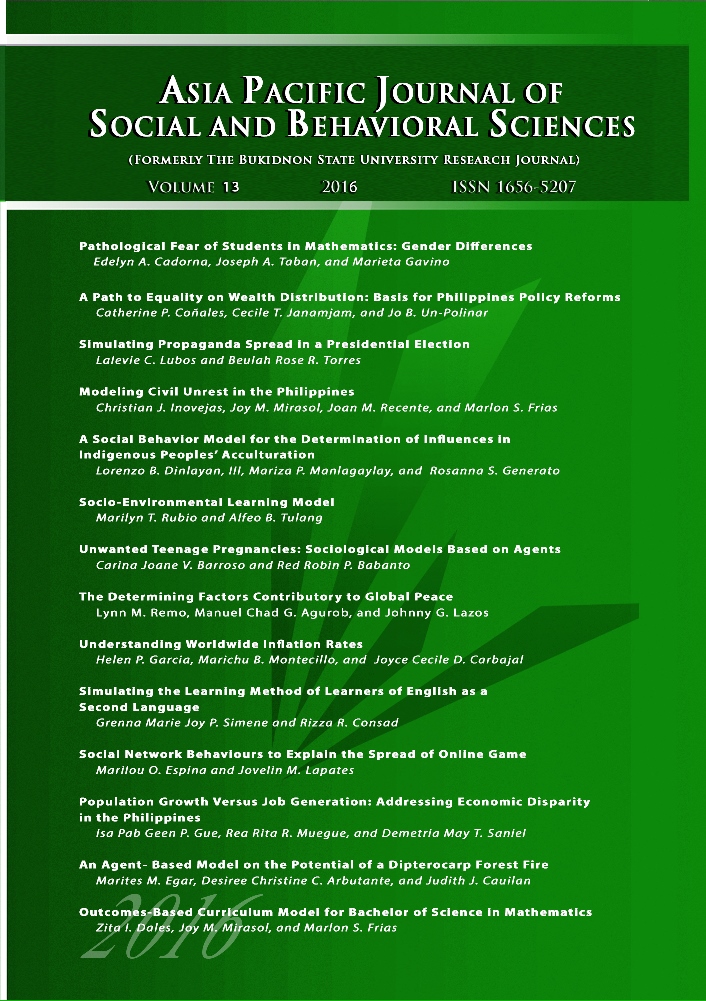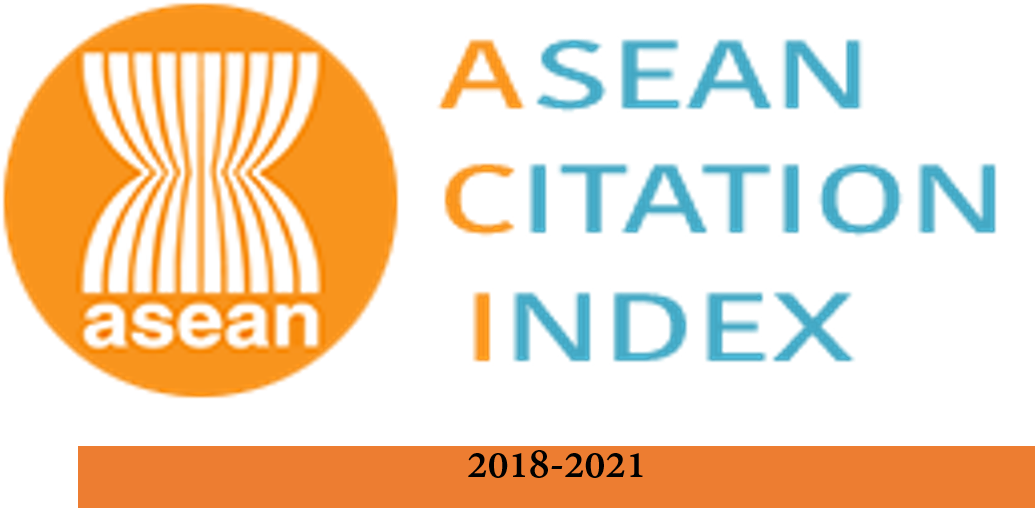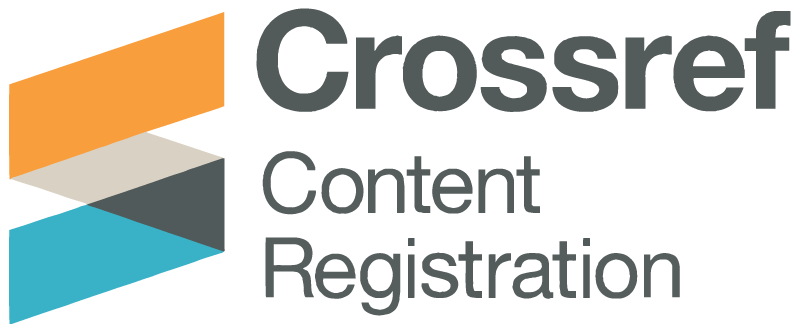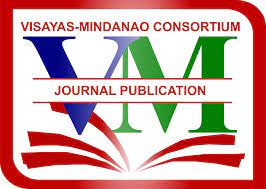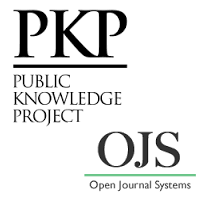Simulating the Learning Method of Learners of English as a Second Language
Abstract
Using the Language Change Model of Wilensky, this study predicted the most effective method in teaching English to second language learners (SLL). Using the parameters as set by the model, this study identified three teaching methods in teaching English to SLL: one-on-one interaction using the English language; group interaction using the English language; and the mixed method (the use of both one-on-one and group interactions, and learners encouraged to use the target language and their native tongue in the interactions). The generated data from the model were statistically treated using regression analysis. The results showed that one-on-one interaction using the English language and group interaction using the English language were the methods ESL learners could better learn the target language rather than through the mixed method. The results implied that a person can learn English without the facility of his/her first language, and that there are methods that are effective in the teaching of English. With the smorgasbord of strategies and methods in English language learning, there are methods that may cater to different kinds of learning. With the proper execution of the method, i.e., group interaction using English, learners can acquire a second language even without the facility of their first language.
Keywords:
NetLogo, Teaching Method, English, Language, one-one-one Method
References
Anderson, M. (2015). The costs of English-only education. Retrieved from http://www.theatlantic.com/education/archive/ 2015/11/the-costs-of-english-only-education/413494/
Beebe, S. A., & Masterson, J. T. (2003). Communicating in small groups. Pearson Education Inc. Boston: Massachusetts.
Berger, M. (2011). English-only policy for all? Case of a University English. Polyglossia, 20.
Butzkamm, W. (2003). We only learn language once. The role of the Mother tongue in FL classrooms: Death of a dogma. Language Learning Journal, 28, 29–39.
DepEd Order 16. s. 2012. Department of Education Order No. 16 (2012).Fortune, T.W. (2012). What the research says about immersion. Center for Research on Language Acquisition. Retrieved from http://carla.umn.edu/immersion/doc uments/ImmersionResearch_TaraFortune.html#_edn9
Gasperetti, M. (2014). Litaliano e la quarta linguapiustudiatanel mondo. Retrieved from http://www.corriere.it/scuola/14_giugno_16/dante-pizza-italiano-uarta-lingua-piu-studiata-mondo-4edfb4fe-f57a-11e3-ac9521682d84f63-shtml?refresh_ce-cp
Ghorbani, M. R. (2013). Sensible of use of L1 promotes EFL learning. Retrieved from www.aaref.com.au/attachment.aspx?id=2312
Harbord, J. (1992). The use of the mother tongue in the classroom. ELT Journal, 46/4, 350-355.
Hatch, E. (1978). Acquisition of syntax in second language. In J. Richards (Ed), Understanding second and foreign language learning. (34–70). Rowley, MA: Newberry House.
Heltemes, L. (2009). Social and academic advantages and disadvantages of within-class heterogeneous and homogeneous ability grouping. Retrieved from http://fisherpub.sjfc.edu/mathcs_etd_masters/93a
Hitotuzi, H. (2002). The mother’s tongue in the L2 teaching-learning symbiosis. Retrieved from http://www.redalyc.org/html/1692/169213802012/
Johnson, D.W., Johnson, R.T., & Smith, K. (2013). Cooperative learning: improving university instruction by basing practice on validated theory. Retrieved from http://personal.cege.umn.edu/~smith/docs/Johnson-Johnson-Smith-Cooperative_Learning-JECT-Small_Group_Learning-draft.pdf
Johnston, J. (2010). Factors that influence language development. University of British Columbia, Canada.
Joy, S., & Kolb, D. (2010). Are there cultural differences in learning style. Retrieved from http://weatherhead.case.educ
Kavaliauskiene, G. (2009). Role of the mother tongue in learning English for specific purposes. ESP World, 8, 1 (22).
Kaye, P. (2008). Teaching one on one. British Council. Retrieved from https://www.teachingenglish.org.uk/article/teaching-one-one
Krashen, S. (1982). Principles and practice in second language acquisition. Pergamon Press: University of South Carolina.
Krashen, S. D. (1985). The input hypothesis: Issues and implications. New York: Longman.
Larsen-Freeman, D. (2000). Techniques and Principles in Language Teaching (2nd ed.) Oxford: Oxford University Press.
Long, M. H. (1981) Input, interaction and second-language acquisition. In H. Winitz (Ed.), Native language and foreign language acquisition: Annals of the New York Academy of Sciences, 379, 259-278. New York: New York Academy of Sciences.
McLeod, S.A. (2014). Lev Vygotsky. Retrieved from Retrieved from www.simplypsychology.org/vygotsky.html
Poole, D. (2008). Interactional Differentiation in the mixed-ability group: a situated view of two struggling readers. Reading Research Quarterly, 43 (3), 228-250.
Richards, J., & Rodgers, T. (2014). Approaches and methods in language teaching (3rd ed.). Cambridge University Press.
Ross, N. J. (2000). Interference and intervention: Using Translation in the EFL classroom. Modern English Teacher, 9 (3), 61-66.
Timor, T. (2012). Use of the mother tongue in teaching a foreign language. Language Education in Asia, 3 (1), 8–14.
Troutman, C., & Wilensky, U. (2007). Net Logo language change model http://ccl.northwestern.edu/netlogo/models/Northwestern University, Evanston, IL.: Center for Connected Learning and Computer-Based Modeling.
Von Worde, R. (2003). Students’ perspectives on foreign language anxiety. Retrieved from http://www.vccaedu.org/inquiry/inquiry-spring2003/i-81-worde.html
Vygotsky, L.S. (1962). Thought and language. Cambridge, MA: MIT Press.
Wenger-Trayner, E., & Wenger-Trayner, B. (2015). Communities of practice: a brief overview and its practice. Retrieved from http://wenger-trayner.com/introduction-to-communities-of-practice/
Wilensky, U. (1999). NetLogo. Retrieved from http://ccl.northwestern.edu/netlogo. Evanston, IL.: Center for Connected Learning and Computer-Based Modeling, Northwestern University.
Yang, A. (2005). Comparison of the effectiveness of cooperative learning and traditional methods on Taiwanese college students’ English oral performance and motivation towards learning. Unpublished doctoral thesis. California: La Sierra University.
Yu, D. (2016). The use of first and second language in Chinese university EFL classroom. Singapore: Springer.
Zimmerman, L. (2010). ESL, EFL, and bilingual education exploring historical, sociocultural, linguistic, and instructional foundations. Charolotte, North Carolina: Information Age Publishing.
Beebe, S. A., & Masterson, J. T. (2003). Communicating in small groups. Pearson Education Inc. Boston: Massachusetts.
Berger, M. (2011). English-only policy for all? Case of a University English. Polyglossia, 20.
Butzkamm, W. (2003). We only learn language once. The role of the Mother tongue in FL classrooms: Death of a dogma. Language Learning Journal, 28, 29–39.
DepEd Order 16. s. 2012. Department of Education Order No. 16 (2012).Fortune, T.W. (2012). What the research says about immersion. Center for Research on Language Acquisition. Retrieved from http://carla.umn.edu/immersion/doc uments/ImmersionResearch_TaraFortune.html#_edn9
Gasperetti, M. (2014). Litaliano e la quarta linguapiustudiatanel mondo. Retrieved from http://www.corriere.it/scuola/14_giugno_16/dante-pizza-italiano-uarta-lingua-piu-studiata-mondo-4edfb4fe-f57a-11e3-ac9521682d84f63-shtml?refresh_ce-cp
Ghorbani, M. R. (2013). Sensible of use of L1 promotes EFL learning. Retrieved from www.aaref.com.au/attachment.aspx?id=2312
Harbord, J. (1992). The use of the mother tongue in the classroom. ELT Journal, 46/4, 350-355.
Hatch, E. (1978). Acquisition of syntax in second language. In J. Richards (Ed), Understanding second and foreign language learning. (34–70). Rowley, MA: Newberry House.
Heltemes, L. (2009). Social and academic advantages and disadvantages of within-class heterogeneous and homogeneous ability grouping. Retrieved from http://fisherpub.sjfc.edu/mathcs_etd_masters/93a
Hitotuzi, H. (2002). The mother’s tongue in the L2 teaching-learning symbiosis. Retrieved from http://www.redalyc.org/html/1692/169213802012/
Johnson, D.W., Johnson, R.T., & Smith, K. (2013). Cooperative learning: improving university instruction by basing practice on validated theory. Retrieved from http://personal.cege.umn.edu/~smith/docs/Johnson-Johnson-Smith-Cooperative_Learning-JECT-Small_Group_Learning-draft.pdf
Johnston, J. (2010). Factors that influence language development. University of British Columbia, Canada.
Joy, S., & Kolb, D. (2010). Are there cultural differences in learning style. Retrieved from http://weatherhead.case.educ
Kavaliauskiene, G. (2009). Role of the mother tongue in learning English for specific purposes. ESP World, 8, 1 (22).
Kaye, P. (2008). Teaching one on one. British Council. Retrieved from https://www.teachingenglish.org.uk/article/teaching-one-one
Krashen, S. (1982). Principles and practice in second language acquisition. Pergamon Press: University of South Carolina.
Krashen, S. D. (1985). The input hypothesis: Issues and implications. New York: Longman.
Larsen-Freeman, D. (2000). Techniques and Principles in Language Teaching (2nd ed.) Oxford: Oxford University Press.
Long, M. H. (1981) Input, interaction and second-language acquisition. In H. Winitz (Ed.), Native language and foreign language acquisition: Annals of the New York Academy of Sciences, 379, 259-278. New York: New York Academy of Sciences.
McLeod, S.A. (2014). Lev Vygotsky. Retrieved from Retrieved from www.simplypsychology.org/vygotsky.html
Poole, D. (2008). Interactional Differentiation in the mixed-ability group: a situated view of two struggling readers. Reading Research Quarterly, 43 (3), 228-250.
Richards, J., & Rodgers, T. (2014). Approaches and methods in language teaching (3rd ed.). Cambridge University Press.
Ross, N. J. (2000). Interference and intervention: Using Translation in the EFL classroom. Modern English Teacher, 9 (3), 61-66.
Timor, T. (2012). Use of the mother tongue in teaching a foreign language. Language Education in Asia, 3 (1), 8–14.
Troutman, C., & Wilensky, U. (2007). Net Logo language change model http://ccl.northwestern.edu/netlogo/models/Northwestern University, Evanston, IL.: Center for Connected Learning and Computer-Based Modeling.
Von Worde, R. (2003). Students’ perspectives on foreign language anxiety. Retrieved from http://www.vccaedu.org/inquiry/inquiry-spring2003/i-81-worde.html
Vygotsky, L.S. (1962). Thought and language. Cambridge, MA: MIT Press.
Wenger-Trayner, E., & Wenger-Trayner, B. (2015). Communities of practice: a brief overview and its practice. Retrieved from http://wenger-trayner.com/introduction-to-communities-of-practice/
Wilensky, U. (1999). NetLogo. Retrieved from http://ccl.northwestern.edu/netlogo. Evanston, IL.: Center for Connected Learning and Computer-Based Modeling, Northwestern University.
Yang, A. (2005). Comparison of the effectiveness of cooperative learning and traditional methods on Taiwanese college students’ English oral performance and motivation towards learning. Unpublished doctoral thesis. California: La Sierra University.
Yu, D. (2016). The use of first and second language in Chinese university EFL classroom. Singapore: Springer.
Zimmerman, L. (2010). ESL, EFL, and bilingual education exploring historical, sociocultural, linguistic, and instructional foundations. Charolotte, North Carolina: Information Age Publishing.

